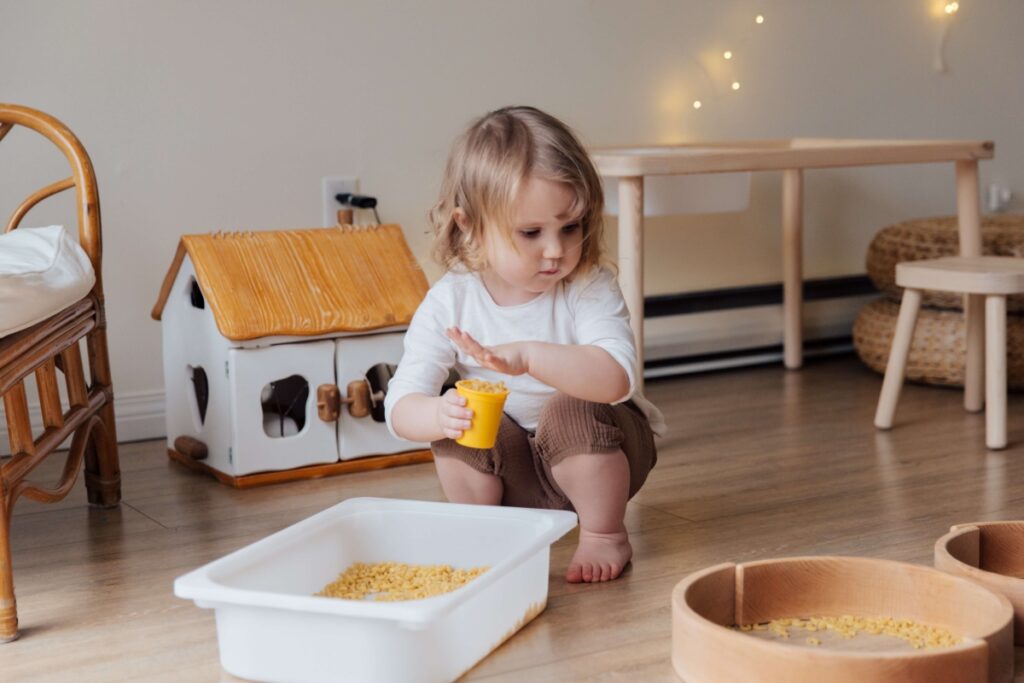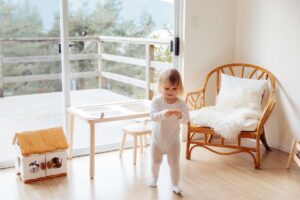Table of Contents
INTRODUCTION:
Child-proofing your home is a top priority for parents and caregivers, and ensuring the safety of your children is paramount. One crucial aspect of child-proofing that often requires special attention is furniture safety. Furniture, although essential for our daily lives, can present potential hazards to curious and adventurous little ones. From sharp edges and corners to unstable structures and tipping risks, it’s important to take proactive measures to child-proof your furniture and create a secure environment for your child to explore and play in.
Accidents involving furniture can happen in an instant, and the consequences can be severe. According to statistics, thousands of children are injured each year due to furniture-related accidents. These accidents can result in cuts, bruises, fractures, and even more serious injuries. As a responsible parent or caregiver, it’s essential to understand the risks associated with furniture and take necessary precautions to prevent these incidents from occurring.
Child-proofing your furniture not only protects your child from potential harm but also offers you peace of mind, knowing that you have done everything possible to ensure their safety. By implementing effective child-proofing strategies, you can create a nurturing environment where your child can freely explore and develop, without constant worry or fear of accidents.
In this comprehensive guide, we will delve into the world of child-proofing furniture. We will explore the reasons why child-proofing furniture is of utmost importance, provide you with a step-by-step assessment process for evaluating the safety of your furniture, and offer practical solutions for child-proofing different types of furniture commonly found in households. We will also discuss how to choose and install furniture safety products, share general tips for child-proofing your home beyond furniture, and highlight the importance of regular maintenance and updates as your child grows.
Whether you are a new parent or an experienced caregiver, this guide will equip you with the knowledge and tools necessary to create a safe and secure environment for your child. By implementing the strategies outlined in this comprehensive guide, you can take proactive steps to child-proof your furniture and minimize the risks associated with furniture-related accidents.
Remember, child-proofing is not a one-time task but an ongoing process. As your child grows and develops new skills, their interaction with furniture will change, and so should your safety measures. With dedication, awareness, and the information provided in this guide, you can ensure that your child’s exploration and playtime are filled with joy, learning, and, most importantly, safety.
1. WHY IS CHILD-PROOFING FURNITURE IMPORTANT?
Child-proofing your furniture is crucial for the safety and well-being of your child. Furniture poses various risks that can lead to accidents and injuries. Understanding the importance of child-proofing furniture will help you realize the significance of taking proactive measures to create a secure environment for your child. Here are several reasons why child-proofing furniture is vital:
- Preventing Accidents and Injuries: Child-proofing your furniture significantly reduces the risk of accidents and injuries. Children possess an innate sense of curiosity and exhibit a natural inclination to explore their environment. They may climb, pull, push, or lean on furniture, increasing the likelihood of accidents. By child-proofing your furniture, you can eliminate or minimize potential hazards, such as sharp edges, unstable structures, or toppling risks, thereby creating a safer environment for your child to play and move around freely.
- Mitigating the Risk of Falls: Furniture-related falls are one of the leading causes of injuries in young children. Toddlers who are just learning to walk or balance themselves are particularly susceptible to falling from chairs, stools, or climbing on top of tables. Child-proofing your furniture can help prevent falls by ensuring stability, securing loose parts, and using appropriate safety measures such as guardrails or safety straps.
- Protecting against Sharp Edges and Corners: Furniture often has sharp edges and corners that can pose a significant risk to young children. Toddlers learning to crawl or walk may inadvertently bump into furniture, leading to painful injuries. Child-proofing with corner guards or edge protectors can help cushion the impact and minimize the severity of injuries.
- Avoiding Furniture Tip-Overs: Unstable furniture can topple over if a child leans or hangs on it. Heavy objects placed on top of furniture can also increase the risk of tip-overs. These incidents can cause serious injuries or even be fatal. By securing furniture to walls or using furniture anchors and straps, you can prevent tip-overs and ensure the stability of your furniture.
- Promoting Child Independence and Exploration: Child-proofing your furniture allows your child to freely explore their environment without constant supervision or restrictions. By creating a safe space, you provide opportunities for your child to develop their motor skills, independence, and curiosity. When your child feels safe and secure, they can confidently navigate their surroundings and engage in age-appropriate activities, fostering their physical and cognitive development.
- Setting a Positive Example and Encouraging Responsible Behaviour: Child-proofing your furniture not only protects your child but also teaches them about safety and responsible behaviour. By implementing safety measures and explaining their purpose to your child, you instil in them the importance of taking precautions and being mindful of their surroundings. This early exposure to safety practices can help them develop a sense of responsibility and awareness as they grow.
- Peace of Mind for Parents and Caregivers: Child-proofing your furniture offers peace of mind to parents and caregivers, knowing that you have taken the necessary steps to ensure your child’s safety. It allows you to focus on other aspects of caregiving without constant worry or fear of accidents. By creating a child-friendly environment, you can relax and enjoy quality time with your child, knowing that they are protected from potential furniture-related hazards.
Child-proofing your furniture is not a luxury but a vital aspect of responsible parenting or caregiving. By understanding the risks associated with furniture and taking proactive measures to address them, you create a secure space where your child can explore, learn, and grow without unnecessary risks. Investing time and effort in child-proofing your furniture is a small price to pay for the priceless safety and well-being of your child.

2. ASSESSING THE SAFETY OF YOUR FURNITURE:
Before implementing child-proofing measures, it’s essential to assess the safety of your furniture. This step allows you to identify potential hazards and determine the necessary actions to create a safer environment for your child. By following a systematic approach, you can thoroughly evaluate each piece of furniture in your home. Here are some key factors to consider when assessing the safety of your furniture:
- Checking for Sharp Edges and Corners: Inspect your furniture for any sharp edges or corners that could pose a risk to your child. Run your hands along the edges and corners to feel for sharpness. Pay particular attention to coffee tables, dining tables, shelves, and other furniture pieces at a child’s height. If you find sharp edges, consider using corner guards or edge protectors to cushion the impact and reduce the risk of injuries.
- Testing Stability: Ensure that your furniture is stable and resistant to tipping. Gently push or apply pressure to different parts of the furniture to check for stability. If a piece of furniture wobbles or feels unstable, it may need reinforcement or adjustment. Unstable furniture poses a significant risk, especially for climbing or adventurous children. Use furniture anchors, brackets, or straps to secure unstable furniture to the wall or floor, preventing tip-overs.
- Evaluating Material Safety: Assess the materials used in your furniture for any potential hazards. Some materials may contain harmful substances like lead-based paint or toxic chemicals. Check for any peeling paint, flaking surfaces, or signs of deterioration. If you find any issues, consider repairing or replacing the furniture. Opt for child-safe materials that are non-toxic and meet safety standards.
- Examining Small Parts and Loose Components: Inspect your furniture for small parts or loose components that could pose a choking hazard to young children. Pay attention to removable knobs, handles, or decorative elements that a child can easily detach. Ensure that all small parts are securely attached or consider replacing them with child-safe alternatives. Regularly check for loose screws, hinges, or fasteners and tighten them to prevent accidents.
- Assessing Accessibility and Reachability: Consider how accessible and reachable certain furniture items are to your child. Low shelves, drawers, or cabinets can be enticing for curious little ones. Ensure that any furniture containing potentially harmful items, such as cleaning supplies or sharp objects, is out of your child’s reach or properly secured with safety latches or locks. Restrict access to certain areas by using safety gates or creating designated child-friendly zones in your home.
- Examining Electrical and Cord Safety: Pay attention to furniture items that are connected to electrical outlets or have cords. Check for any exposed wires, frayed cords, or loose electrical connections. Make sure that cords are properly secured and out of your child’s reach to avoid potential electrical hazards. Use cord organizers or covers to keep cords tidy and prevent entanglement.
By carefully assessing the safety of your furniture, you can identify potential risks and take appropriate actions to mitigate them. Remember, child-proofing is not a one-size-fits-all approach. Each piece of furniture may require specific safety measures based on its characteristics and location within your home. Regularly re-evaluate the safety of your furniture as your child grows and their needs change. By addressing potential hazards, you can create a secure environment where your child can freely explore and play without unnecessary risks.
3. Child-Proofing Solutions for Different Types of Furniture:
Child-proofing your furniture requires tailored solutions to address the specific risks associated with each type of furniture. By implementing appropriate measures, you can minimize potential hazards and create a safer environment for your child. Here are child-proofing solutions for different types of furniture commonly found in households:
- Tables and Countertops: Tables and countertops are prone to sharp edges and corners, which can pose a risk of injuries to children. Apply corner guards or edge protectors to cushion the impact and prevent accidents. Additionally, use tablecloths with clips or weights to secure them, preventing children from pulling them down and potentially causing items to fall.
- Chairs and Stools: Chairs and stools can be unstable, leading to falls or tip-overs. Ensure that chairs and stools are sturdy and in good condition. Avoid using chairs or stools with wheels or those that easily tip backward. If necessary, consider replacing them with more stable alternatives. Adding non-slip pads to the bottom of chair legs can also improve stability.
- Cabinets and Drawers: Cabinets and drawers often contain hazardous items such as cleaning supplies, sharp objects, or medications. Install safety latches or locks on cabinets and drawers to prevent your child from accessing these potentially dangerous items. Magnetic locks or adhesive strap locks are effective options that keep cabinets securely closed while allowing easy access for adults.
- Shelving Units and Bookcases: Secure tall and freestanding shelving units and bookcases to the wall using furniture anchors or straps. This prevents them from toppling over when a child attempts to climb or pull on them. Avoid placing heavy items or objects that can be easily pulled down from higher shelves. Organize and store items in a way that distributes weight evenly to maintain stability.
- TVs and Entertainment Centres: Flat-screen TVs and entertainment centres can be hazardous if they tip over. Mount your TV securely to the wall or use a stable TV stand designed for stability. Keep cords and cables organized and out of reach to avoid entanglement hazards. Use cord covers or cord concealers to prevent children from accessing and pulling on cords.
- Other Furniture Considerations: Take into account other furniture items in your home that may require child-proofing. For example, secure freestanding mirrors to the wall or use safety straps to prevent them from tipping over. Cover sharp corners on furniture like dressers or side tables with corner guards. Remove any unstable or rickety furniture that may pose a risk.
It’s important to note that child-proofing solutions should be carefully selected based on the specific characteristics of your furniture and the needs of your child. Evaluate each piece of furniture individually and consider the age and developmental stage of your child. Regularly inspect and maintain child-proofing devices to ensure their effectiveness.
4. Choosing and Installing Furniture Safety Products:
Choosing and installing the right furniture safety products is a crucial step in child-proofing your home. These products provide an additional layer of protection to ensure the safety of your child. Here are some important considerations when selecting and installing furniture safety products:
- Corner Guards and Edge Protectors: Corner guards and edge protectors are essential for preventing injuries from sharp edges and corners. Choose corner guards made of soft and cushioned materials such as foam or rubber. Ensure that they are securely attached using adhesive or screws, following the manufacturer’s instructions. Opt for corner guards that blend well with your furniture or choose transparent options to maintain the aesthetic appeal.
- Furniture Anchors and Straps: Furniture anchors and straps are designed to prevent furniture tip-overs, especially for tall or top-heavy items. When selecting furniture anchors, ensure they are suitable for the size and weight of your furniture. Follow the installation instructions carefully, ensuring a secure attachment to the wall or floor. Regularly inspect and tighten the anchors to maintain their effectiveness.
- Safety Latches and Locks: Safety latches and locks are essential for cabinets, drawers, and other storage spaces that may contain hazardous items. Choose child-resistant latches that are easy for adults to operate but difficult for children to open. Magnetic latches, adhesive strap locks, or push-button locks are popular options. Test the latches and locks after installation to ensure they are properly secured.
- Anti-Tip Brackets: Anti-tip brackets are specifically designed to prevent furniture from tipping over. They are typically used for large furniture items like dressers, bookcases, or entertainment centres. Follow the manufacturer’s instructions to install the brackets securely. It’s important to anchor the furniture to the wall studs for maximum stability. Regularly inspect and adjust the brackets as needed.
- Other Considerations: Depending on your specific furniture and child-proofing needs, additional safety products may be required. For example, cord organizers or covers can keep electrical cords tidy and out of your child’s reach. Non-slip pads or mats can be placed under rugs or furniture to prevent slipping or sliding. Door stoppers or finger guards can protect little fingers from getting trapped in closing doors.
When choosing furniture safety products, prioritize quality and effectiveness over cost. Opt for products that meet safety standards and have positive reviews from reputable sources. Consider consulting with professionals or seeking recommendations from other parents or caregivers who have experience in child-proofing.
During the installation process, carefully read and follow the manufacturer’s instructions. Ensure that the products are properly installed and securely attached. Regularly check and maintain the safety products to ensure their continued effectiveness.
Remember, child-proofing is not a substitute for supervision. It is essential to actively supervise your child, especially in areas where child-proofing measures are in place. Additionally, educate your child about potential dangers and teach them how to safely interact with furniture and their surroundings.
By choosing and installing appropriate furniture safety products, you can significantly reduce the risk of accidents and create a safer environment for your child. Stay vigilant, regularly inspect the installed safety products, and make necessary adjustments as your child grows and their needs change.

5. General Tips for Child-Proofing Your Home:
Child-proofing your home goes beyond just focusing on furniture safety. It involves creating a comprehensive environment that minimizes potential hazards and promotes the safety and well-being of your child. Here are some general tips to consider when child-proofing your home:
- Keep Small Objects out of Reach: Small objects pose a choking hazard to young children. Keep small toys, coins, batteries, and other small items out of your child’s reach. Regularly scan the floor and low-lying surfaces for any potential choking hazards and promptly remove them.
- Secure Cords and Electrical Outlets: Ensure that electrical cords are safely secured and out of your child’s reach. Use cord organizers, covers, or cord shorteners to prevent tripping hazards and discourage your child from playing with them. Install outlet covers or child-proof outlet plates to prevent accidental electrical shocks.
- Use Safety Gates: Safety gates are essential for restricting access to certain areas of your home, such as stairs or rooms with potential hazards. Choose gates that meet safety standards and install them securely. It is important to adhere to the manufacturer’s guidelines for correct installation and regularly inspect the gates for any indications of wear or harm.
- Create a Safe Play Area: Designate a safe play area for your child, particularly if you have open spaces or rooms with potential dangers. Use playpens, play yards, or baby gates to create a secure and supervised space where your child can play freely. Ensure that the play area is free from hazards, such as sharp edges, unstable furniture, or small objects.
- Supervise and Educate: Active supervision is crucial in preventing accidents and injuries. Always keep an eye on your child, especially in areas that may have potential risks. Educate your child about safety rules and potential dangers. Teach them how to interact safely with furniture, appliances, and other items in your home.
- Secure Heavy Furniture and Appliances: Secure heavy furniture and appliances to prevent tipping or falling. Use furniture anchors, brackets, or straps to secure items like bookshelves, TVs, or dressers to the wall or floor. Securely mount TVs and other heavy items to wall mounts or stable furniture stands.
- Lock Cabinets and Drawers: Install safety latches or locks on cabinets and drawers that contain potentially hazardous items. Keep cleaning supplies, sharp objects, medications, and other dangerous substances locked away and out of your child’s reach. Store these items in high cabinets or use child-proof locks to prevent access.
- Apply corner guards or edge protectors to furniture with sharp corners or edges. This includes coffee tables, countertops, or low-lying shelves. These safety measures help cushion potential impacts and minimize the risk of injuries.
- Be Mindful of Hot Surfaces and Appliances: Take precautions to prevent burns and scalds. Keep hot beverages, pots, and pans out of your child’s reach. Use stove knob covers to prevent accidental ignition. Turn pot handles away from the edge of the stove, ensuring they are not easily accessible to your child.
- Secure Windows and Blind Cords: Windows and blind cords can pose risks to young children. Install window guards or window locks to prevent accidental falls. Keep blind cords out of reach and use cord winders or cord cleats to secure them. Cut looped cords or use cordless blinds or curtains to eliminate the risk of strangulation.
6. Maintaining a Child-Proofed Home:
Maintaining a child-proofed home is essential to ensure ongoing safety for your child. As they grow and develop new skills, their interaction with the environment changes, making regular inspections and updates crucial. Here are some key aspects to consider when maintaining a child-proofed home:
- Regular Inspections and Maintenance: Schedule regular inspections of your child-proofing measures to identify any potential issues or areas that require attention. Check furniture anchors, straps, and latches to ensure they are still secure and functioning properly. Examine corner guards, edge protectors, and safety gates for signs of wear or damage. Replace any worn-out or broken child-proofing devices promptly.
- Updating Safety Measures as Your Child Grows: Child-proofing needs evolve as your child grows and develops new abilities. Stay aware of their milestones and adjust your safety measures accordingly. As your child becomes more mobile and curious, they may find new ways to interact with their environment. Reassess the placement of furniture, the accessibility of certain items, and the need for additional safety products to address changing risks.
- Consider Age-Appropriate Changes: Different stages of childhood require different child-proofing strategies. For example, as your child learns to crawl, focus on ensuring that furniture is stable and free from potential hazards like sharp edges. As they start walking and climbing, prioritize securing furniture to prevent tip-overs. Be mindful of changes in your child’s abilities and adapt your child-proofing measures accordingly.
- Maintain Cleanliness and Organization: Keeping your home clean and organized plays a crucial role in maintaining a child-proofed environment. Clutter can increase the risk of accidents, such as tripping or falling. Regularly tidy up toys, remove unnecessary items from the floor, and ensure walkways are clear. Properly store and label hazardous substances, ensuring they are out of your child’s reach.
- Communicate with Caregivers and Visitors: If you have caregivers or visitors in your home, ensure they are aware of your child-proofing measures and guidelines. Communicate the importance of adhering to safety practices and maintaining a safe environment for your child. Encourage open communication and address any concerns or questions they may have regarding child-proofing.
- Stay Updated on Safety Guidelines: Stay informed about the latest safety guidelines and recommendations. Safety standards and best practices may evolve over time, and it’s important to stay updated with any new information. Keep an eye on product recalls or safety alerts related to child-proofing products, furniture, or other household items.
- Educate Your Child: As your child grows older, it’s crucial to educate them about safety and responsible behaviour. Teach them about potential hazards, how to use furniture safely, and the importance of following safety rules. Encourage them to communicate any concerns or dangers they notice. Foster a sense of responsibility and awareness in your child to promote a safer environment.
- Seek Professional Advice if Needed: If you have concerns or need guidance in maintaining a child-proofed home, don’t hesitate to seek professional advice. Childproofing experts, paediatricians, or child safety organizations can provide valuable insights and recommendations specific to your home and child’s needs.

CONCLUSION:
In conclusion, child-proofing your furniture and creating a safe environment for your child is a critical responsibility for parents and caregivers. Throughout this comprehensive guide, we have explored the importance of child-proofing furniture, assessed the safety of various furniture items, and provided practical solutions and tips for child-proofing your home. By implementing these measures, you can significantly reduce the risk of accidents and injuries, allowing your child to explore and play in a secure space.
Child-proofing furniture is essential because it prevents accidents and injuries, mitigates the risk of falls, protects against sharp edges and corners, avoids furniture tip-overs, promotes child independence and exploration, sets a positive example of responsible behavior, and provides peace of mind for parents and caregivers. By understanding these reasons, you can recognize the significance of taking proactive measures to child-proof your furniture.
Assessing the safety of your furniture is a crucial step in the child-proofing process. By checking for sharp edges and corners, testing stability, evaluating material safety, examining small parts and loose components, and assessing accessibility and reachability, you can identify potential hazards and take appropriate actions to create a safer environment for your child.
Child-proofing solutions for different types of furniture have been discussed extensively. From tables and countertops to chairs and stools, cabinets and drawers to shelving units and bookcases, and TVs and entertainment centres, each type of furniture requires tailored safety measures. By using corner guards and edge protectors, furniture anchors and straps, safety latches and locks, and anti-tip brackets, you can effectively child-proof your furniture and reduce potential risks.
Choosing and installing furniture safety products is an essential aspect of child-proofing. By carefully selecting corner guards, furniture anchors, safety latches, and other safety devices, and following the manufacturer’s instructions for installation, you can ensure maximum effectiveness in protecting your child.
Additionally, we have discussed general tips for child-proofing your home, including keeping small objects out of reach, securing cords and electrical outlets, using safety gates, creating a safe play area, supervising and educating your child, securing heavy furniture and appliances, covering sharp corners and edges, and being mindful of hot surfaces and appliances.
Maintaining a child-proofed home is an ongoing process that requires regular inspections and updates. By conducting inspections, updating safety measures as your child grows, considering age-appropriate changes, maintaining cleanliness and organization, communicating with caregivers and visitors, staying updated on safety guidelines, educating your child, and seeking professional advice when needed, you can ensure the continued safety of your child in your home.
In conclusion, child-proofing your furniture and maintaining a child-proofed home is a vital aspect of creating a safe environment for your child to thrive. By implementing the strategies and tips provided in this guide, you can significantly reduce the risk of accidents and injuries, allowing your child to explore, learn, and play in a secure and nurturing space.
Remember, child-proofing is not a one-time task but an ongoing commitment. Stay vigilant, adapt your child-proofing measures as your child grows, and prioritize their safety at all times. By doing so, you can provide them with a safe and loving environment that promotes their development, growth, and happiness.
Frequently Asked Questions (FAQs):
Q: When should I start child-proofing my furniture?
A: It is recommended to start child-proofing your furniture before your child becomes mobile, usually around 6 to 8 months of age.
Q: What are some other general child-proofing tips for the home?
A: In addition to child-proofing furniture, secure staircases with gates, cover electrical outlets, install window guards, and store cleaning supplies and medications out of reach.
Q: How often should I update my child-proofing measures?
A: Regularly reassess your child-proofing measures as your child grows and develops new skills. Aim to update safety measures every few months or whenever you notice changes in your child’s abilities or behaviour.
Q: Are there any child-proofing measures specific to outdoor furniture?
A: Outdoor furniture should also be child-proofed to ensure safety. Secure outdoor tables and chairs to prevent tipping, use cushions or covers to protect against sharp edges, and store outdoor tools and equipment in locked cabinets or sheds.
Q: What should I do if I notice a child-proofing product is damaged or no longer effective?
A: If you find a damaged child-proofing product or one that is no longer effective, replace it immediately. Regularly inspect your safety devices and ensure they are in good condition to maintain a safe environment for your child.
Q: Can I child-proof antique or fragile furniture?
A: Yes, you can child-proof antique or fragile furniture. Use clear adhesive tape to secure loose parts, cover sharp edges with padded materials, and consider displaying fragile items out of your child’s reach or in locked cabinets.
Q: Are there any child-proofing solutions for open shelving or bookcases?
A: To child-proof open shelving or bookcases, secure them to the wall using furniture anchors or straps. Place heavier items on lower shelves to prevent toppling, and consider using bins or baskets to store small objects.
Q: Should I child-proof furniture in rooms where my child spends less time?
A: It’s important to child-proof all areas of your home, even if your child spends less time in certain rooms. Accidents can happen quickly, so it’s best to ensure safety throughout your entire living space.
Q: Can I child-proof furniture without compromising its aesthetics?
A: Yes, child-proofing can be done without compromising the aesthetics of your furniture. Many child-proofing products are designed to be discreet, such as transparent corner guards or edge protectors that blend well with the furniture.
Q: How can I teach my child about furniture safety?
A: Teach your child about furniture safety by setting clear rules and boundaries, explaining potential dangers, and demonstrating safe behaviours. Engage them in child-friendly discussions and activities that promote understanding and responsibility.
Q: Is it necessary to child-proof furniture in rooms where my child is always supervised?
A: While supervision is important, accidents can still occur even under supervision. It is recommended to child-proof furniture in all areas of your home to create a consistent safe environment for your child.
Q: Are there any child-proofing measures for heavy furniture that cannot be moved?
A: If heavy furniture cannot be moved, secure it to the wall using furniture anchors or brackets. Distribute the weight evenly and avoid placing heavy objects on top shelves. Consider professional assistance for securing exceptionally heavy furniture.
Q: How do I child-proof furniture with glass elements
A: To child-proof furniture with glass elements, you can apply clear adhesive safety film to the glass surfaces. This helps prevent shattering and reduces the risk of injury if the glass does break. Additionally, ensure that glass shelves or tabletops are securely attached and consider using corner protectors to cushion any sharp edges.
Q: Can I use DIY methods for child-proofing furniture?
A: While there are some DIY child-proofing methods that can be effective, it is important to ensure they meet safety standards. It is generally recommended to use certified child-proofing products that have been tested for safety and effectiveness.
Q: How can I teach my child to respect and follow the child-proofing measures?
A: Consistent reinforcement of safety rules and explaining the reasons behind child-proofing measures can help teach your child to respect and follow them. Lead by example, praise them for safe behaviour, and redirect their attention to child-friendly areas and activities.
Q: Should I remove child-proofing measures as my child gets older?
A: Gradually removing child-proofing measures as your child grows and demonstrates responsible behaviour is appropriate. However, it is important to assess the situation and ensure your child is ready for the increased freedom without compromising their safety.
Q: How can I ensure that my child does not tamper with child-proofing devices?
A: Regularly check child-proofing devices to ensure they are intact and functioning properly. If your child shows an inclination to tamper with or bypass safety measures, consider reinforcing the devices or using alternative methods to prevent their manipulation.
Q: Are there any child-proofing measures specifically for cribs and baby beds?
A: Cribs and baby beds should meet safety standards and have no loose or broken parts. Use fitted sheets without any gaps, avoid placing pillows or blankets in the crib, and ensure that the crib bars are properly spaced to prevent entrapment.
Q: How can I child-proof furniture with drawers that my child can easily open?
A: For furniture with drawers that your child can easily open, use safety latches or locks specifically designed for drawers. These devices prevent your child from accessing the contents and reduce the risk of accidents or injuries.
Q: Should I consider professional child-proofing services?
A: Professional child-proofing services can provide expert advice and assistance in ensuring the safety of your home. They can assess potential risks, recommend appropriate solutions, and properly install child-proofing devices for maximum effectiveness and peace of mind.
By addressing these frequently asked questions, we hope to provide you with further clarity and guidance on child-proofing your furniture and creating a safe environment for your child. Remember, every child is unique, so tailor your child-proofing measures to their specific needs and developmental stage. With dedication and vigilance, you can maintain a safe and secure home where your child can thrive and explore with confidence.
Don’t forget to shop the best in designer and contemporary furniture with us at D Touch Living Concept!
Happy Child-Proofing!








